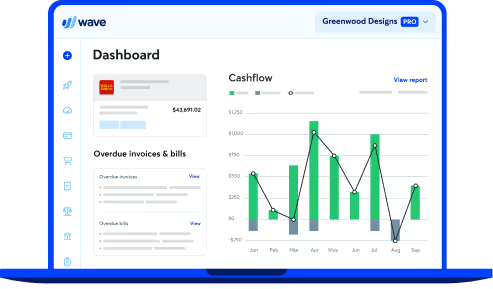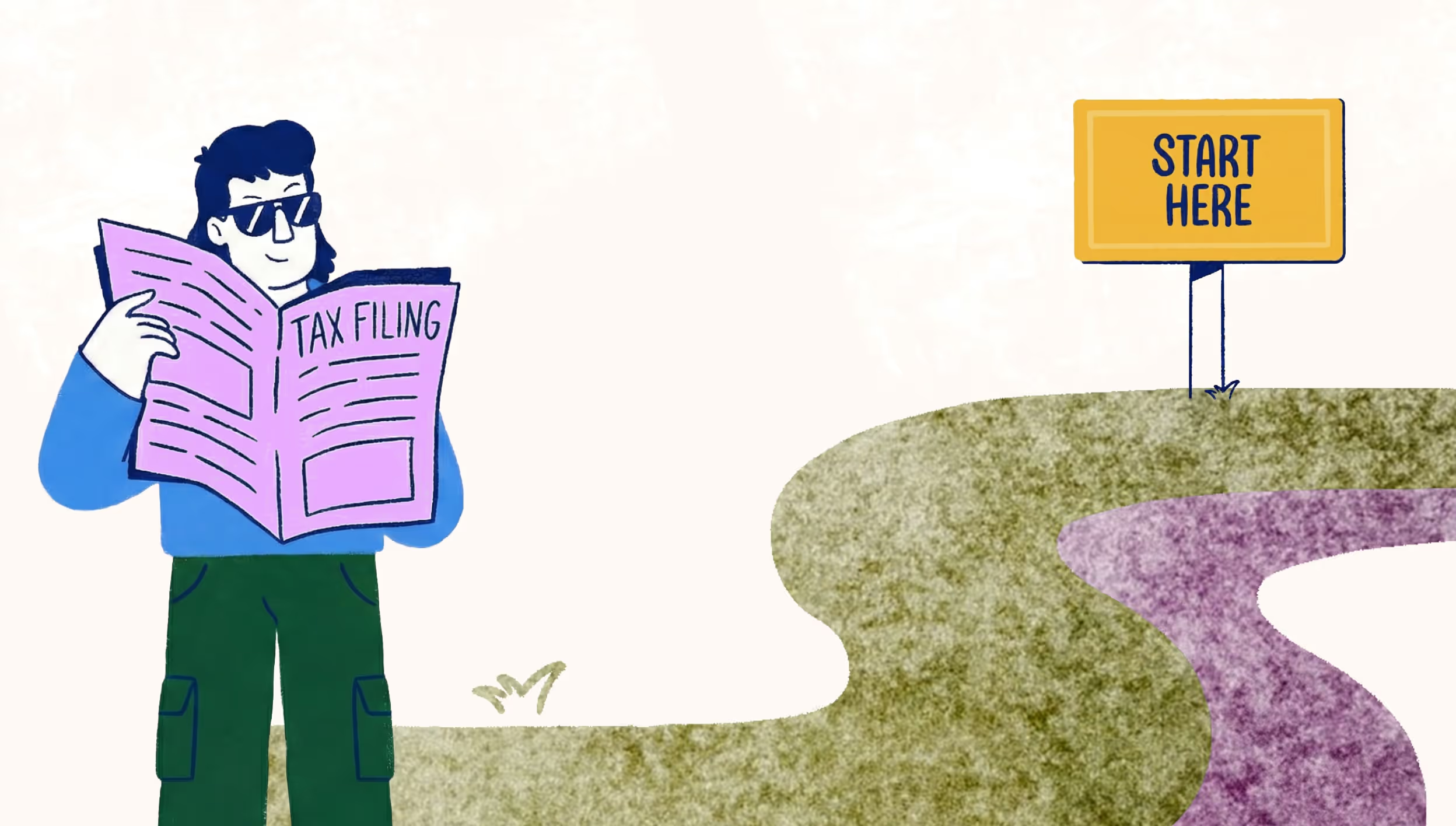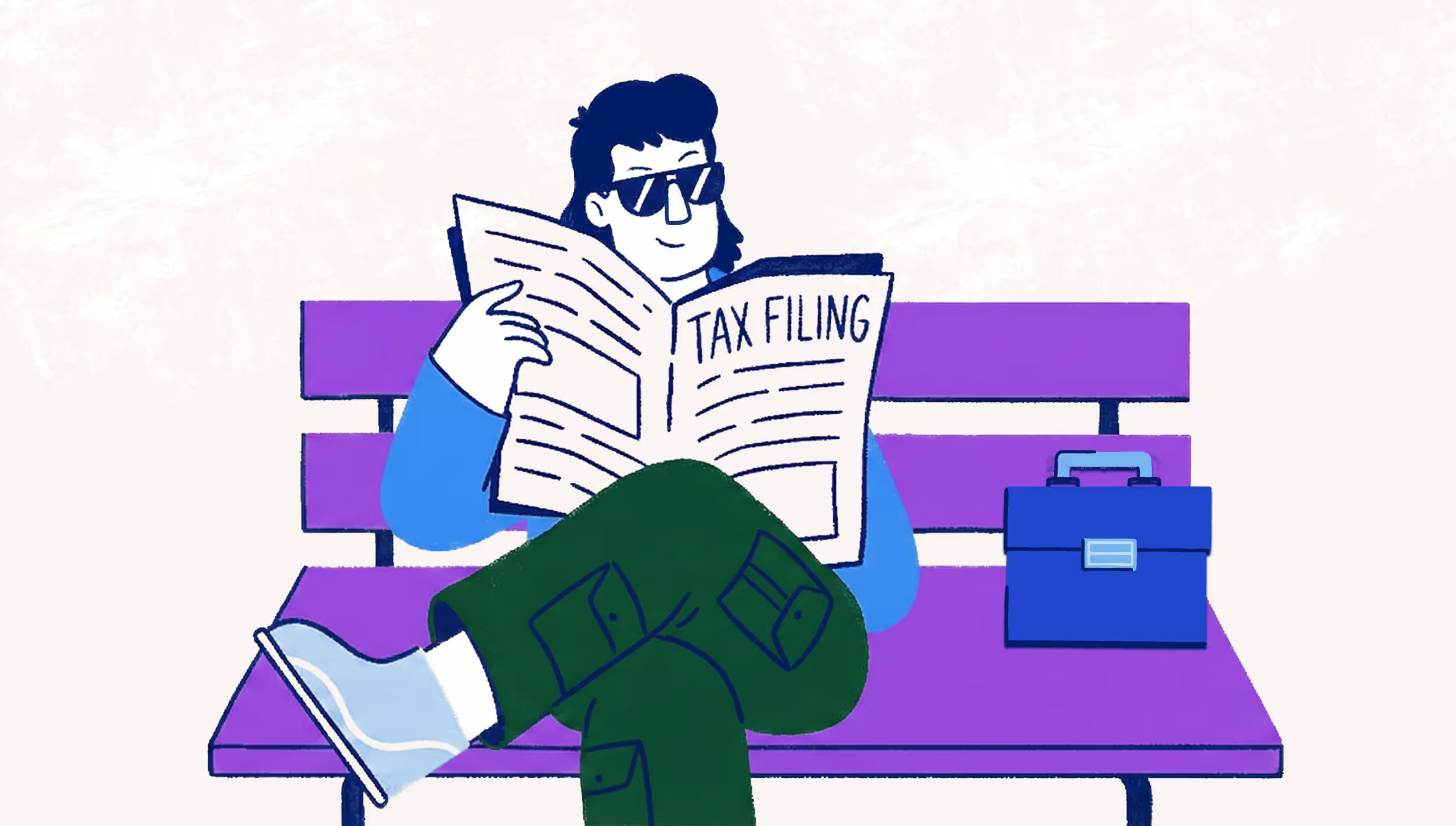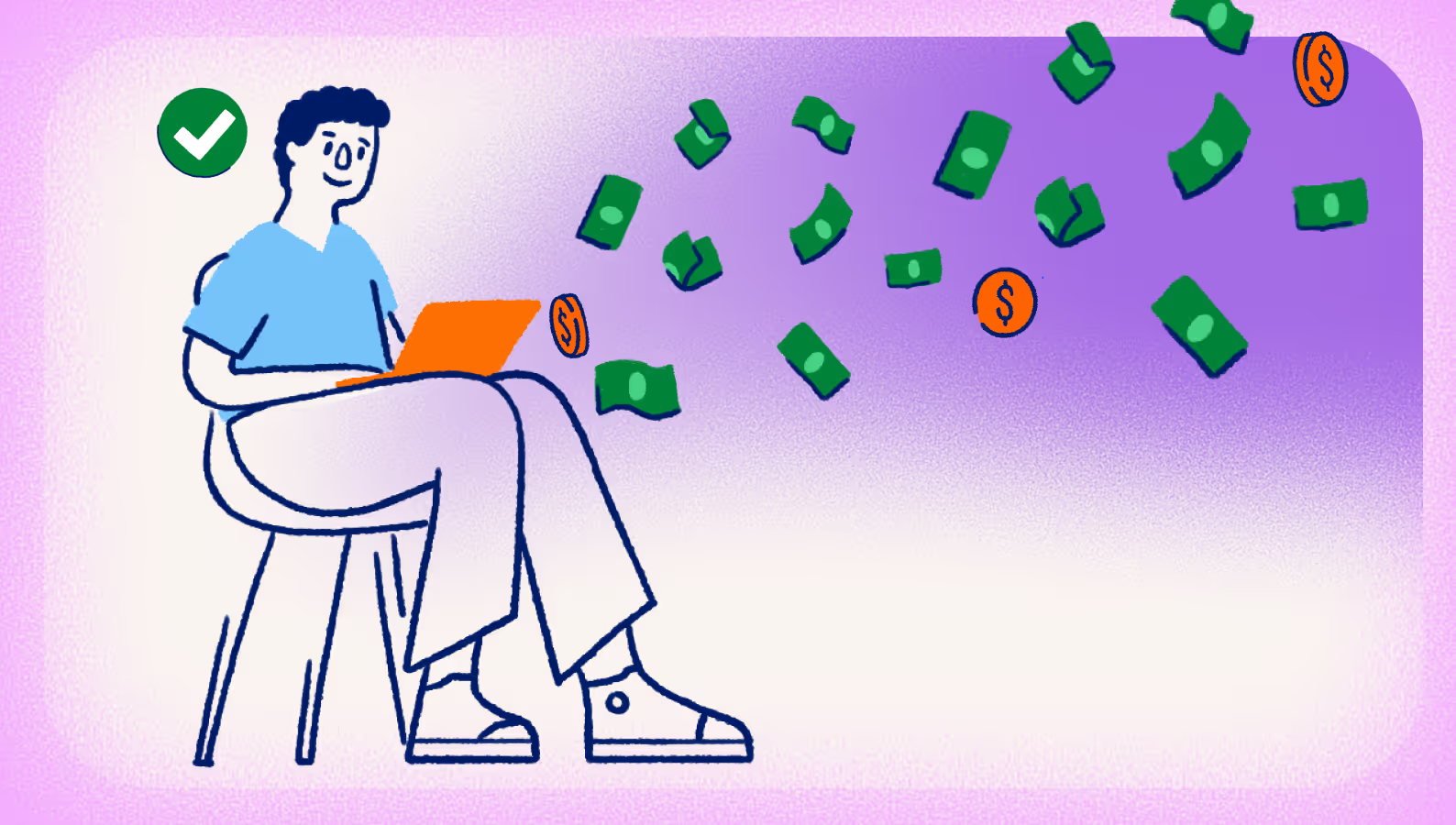
Managing cash flow: 7 tips for solopreneurs to avoid money crunches
Cash flow gives you a clear picture of your business’s health: what’s coming in, what’s going out, and what’s left to work with.
And for solopreneurs, staying on top of cash flow isn’t just smart. It’s what keeps the lights on, the coffee flowing, and your dreams cruising forward. It’s also the key to avoiding those late-night “should I sell everything and move to a cabin in the woods?” moments.
Late client payments. Surprise bills. Slow seasons. These aren’t edge cases. They’re all initiation rites for being your own boss. But not having a handle on your cash flow is like riding a rollercoaster without a seatbelt: thrilling until it’s not, right?
The good news? Forecasting and managing cash flow is simpler than it sounds.
Here are seven practical ways to take control and keep your cash flow flowing:
- Separate your business and personal finances
- Forecast your cash flow on a monthly basis
- Build and maintain a cash reserve
- Get paid faster with online-enabled invoices
- Schedule major expenses strategically
- Cut unnecessary expenses regularly
- Diversify income streams
Separate your business and personal finances
Mixing business and personal expenses might feel harmless—until tax time hits and you’re trying to remember if that $76 sushi order was for a client lunch or your cousin’s birthday.
Beyond the receipt confusion, using one account for everything makes it harder to know how your business is actually performing. It blurs your numbers, muddles your deductions, and makes planning more guesswork than strategy.
And if your business is incorporated, it’s not just messy—it’s risky. When personal and business spending overlap, you could lose the legal protections that come with incorporation. That means your personal assets might be on the hook if things go south.
Bottom line: making sure you separate business and personal finances isn’t just tidy. It’s protective—and it pays off.
Here’s what it helps you do:
- Avoid overpaying on taxes
- Stay audit-ready with cleaner records
- Get a clearer view of how your business is actually performing
- Make informed decisions about your business finances
- Reduce stress and stay organized when tax season rolls around
- Protect your personal assets by keeping your business legally separate (if your business is incorporated)
Here’s how to do it:
- Open a dedicated business bank account (and credit card, if needed)
- Set up a way to pay yourself—don’t just pay yourself at random
- Track everything in one place using accounting software like Wave’s
- Keep records clean—no personal purchases on the business card (and vice versa)
Pro tip: If you’re in the US, opening a Bluevine Business Checking account through Wave gets you 6 months of Wave’s Pro Plan free, plus 3 months of an upgraded Bluevine plan.
In Canada? Choose a low or no-fee business account that lets you keep things separate and easy to track.
Forecast your cash flow on a monthly basis
A monthly cash flow projection or forecast helps you see what’s coming. So when a big bill hits or a client payment runs late, you’re ready, not scrambling.
Before you dive in, here are two terms worth knowing:
- Accounts receivable: Money you expect to collect, like client payments, deposits, or grants.
- Accounts payable: Money you expect to spend, like rent, subscriptions, taxes, or vendor bills.
Here’s how to build your monthly forecast, step by step:
- Gather your financial documents. Invoices, bank statements, upcoming bills—anything that helps you estimate income and expenses.
- Find your opening balance. Check how much cash is in your business account on the first of the month.
- List your expected income. This is your accounts receivable. Include client payments, deposits, loans, and other inflows.
- List your expected expenses. Your accounts payable. Think rent, tools, payroll, taxes, inventory—anything leaving your account.
- Calculate your net cash flow. Subtract expenses from income.
- Project your ending balance. Add your net cash flow to your opening balance.
Let’s break this down with an example. Here’s how a monthly cash flow forecast could look in real life, using a freelance consultant’s business as an example.
- Starting balance: $2,000 in the business account
- Incoming cash: $5,000 expected from client work
- Outgoing expenses: $3,500 for software, taxes, and rent
Based on those numbers, the cash flow forecast breaks down as follows:
- $5,000 income − $3,500 expenses = $1,500 net cash flow
- $2,000 opening balance + $1,500 net cash flow = $3,500 projected ending balance
This gives a clear picture of how cash flow will shake out for the month, and you’ll know whether you can breathe easy or need to pause on buying that standing desk you’ve been eyeing.
Tip: Use software to make cash flow forecasting easier.
If you’re using Wave, you can pull your financial data straight from the Reports section and plug it into a monthly forecast. No spreadsheets, no stress.
Not a Wave user yet? Try our free cash flow calculator to map out a projection.
And check out our other cash flow resources if you’d like to go deeper on this topic:
- Explore different cash flow formulas to understand what they reveal about your business.
- Learn how to build a longer-term cash flow projection to get ahead of seasonal shifts or slow months.
- Or brush up on how to read a full cash flow statement if you’re ready to level up your financial reporting game.
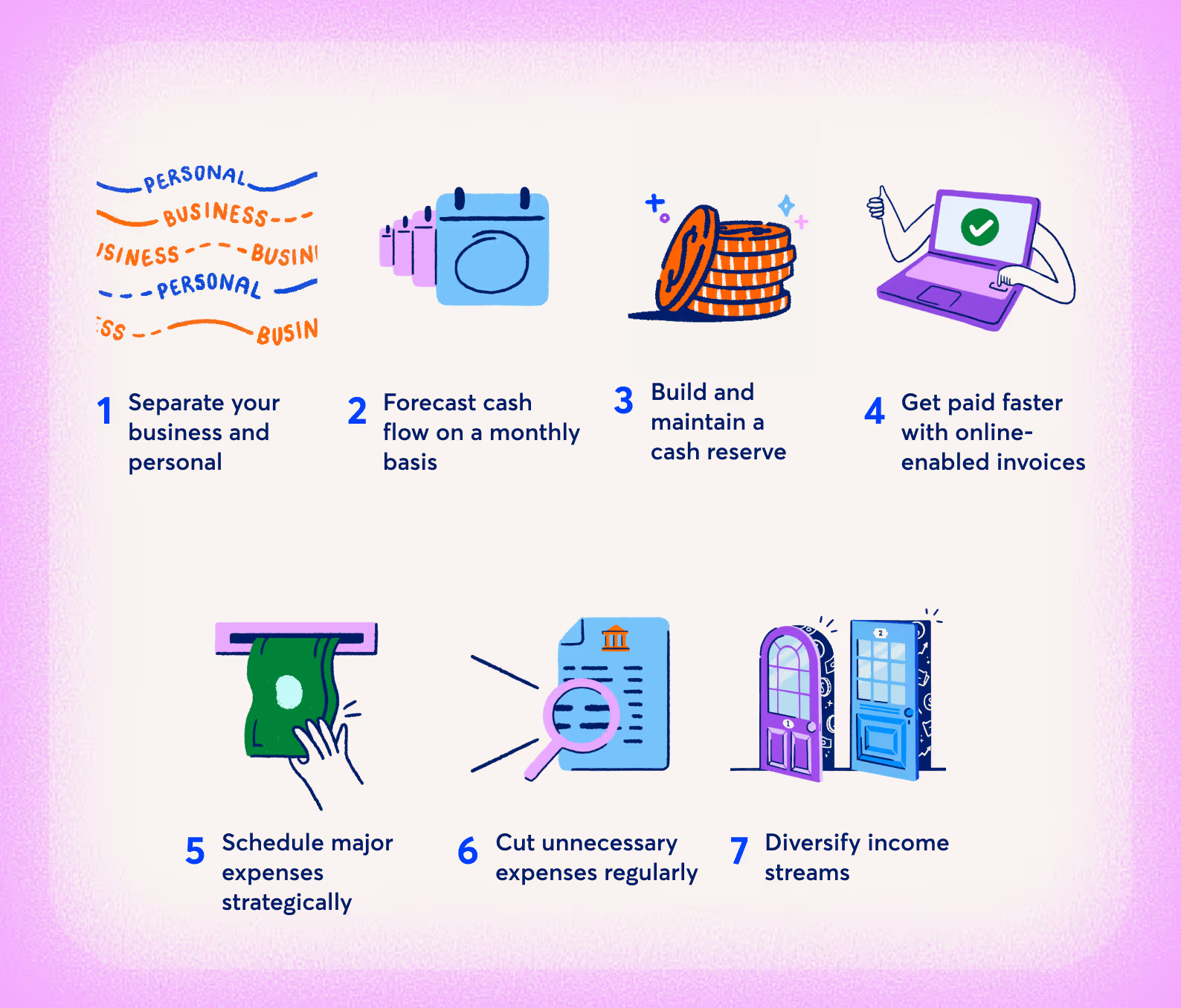
Build and maintain a cash reserve
Every solopreneur needs a cash reserve, an emergency fund you can access when clients ghost, invoices lag, or your laptop dies mid-project.
A common rule of thumb is to save at least three months’ worth of business expenses as your cash reserve.
For example, if a consulting business typically spends $4,000 a month on software, contractors, and rent, your goal would be to have a $12,000 cash reserve available at all times. That might sound out of reach, but even small, regular contributions—$100 or $250 a month—can add up fast.
Open a separate business savings account, set up an automatic transfer, and treat your cash reserve deposits like a non-negotiable expense.
Most small businesses experience at least one cash flow crunch each year. A reserve gives you the freedom to ride it out without dipping into personal funds or scrambling to make ends meet.
Get paid faster with online-enabled invoices
Slow payments are one of the most common causes of cash flow stress. The longer money sits in limbo, the harder it is to cover your own bills.
Say you’re a graphic designer. You’ve wrapped a project and sent the invoice. A week passes. Then another. Your client says they’ll “get to it soon.” Meanwhile, your rent’s due and your design software just auto-renewed. Sound familiar?
Delayed payments are common, but they don’t have to be.
Wave’s online payments feature makes it easier to get paid fast by offering built-in payment options. Instead of mailing a check, your client can pay your invoices instantly online.
And the numbers back it up:
- Wave users with automatic payments and saved payment info get paid in 1.3 days
- Those without saved info get paid in 10.2 days
- Manual payments average 12 days
That’s the difference between scrambling to cover rent and smooth, steady cash flow.
With Wave’s online payments feature, you can send estimates, enable automatic payments, and request upfront deposits directly from your estimates, making it easier to keep cash flowing as work gets underway.
Schedule major expenses strategically
Big expenses aren’t always avoidable, but when you spend can make all the difference. Timing large purchases around your income cycle helps prevent surprise dips and keeps your cash flow steady.
Here’s how to time your spending like a pro:
- Budget for tax season. Don’t scramble in April. Build tax payments into your monthly forecast and set aside 25–30% of your income in a separate account throughout the year.
- Time purchases around strong income months. If you know Q4 is your busy season, wait to make big purchases—like new software, equipment, or marketing hires—until revenue is more predictable.
- Plan ahead to catch seasonal deals. Black Friday, back-to-school, Boxing Day—buying during sales (not out of desperation) can save serious money.
- Negotiate payment terms up front. Don’t just accept the default. Ask about splitting payments or shifting the due date to match your income cycle. Most vendors have wiggle room—you just have to ask.
- Spread out recurring costs. If all your renewals land in the same month, see if you can stagger them. Even spacing helps avoid lopsided cash flow.
- Set a spending threshold. Create a simple rule: for any purchase over $500 (or whatever amount makes sense for you), wait 30 days and check your forecast first. That pause can save your buffer.
Here’s how this looks in the real world.
Let’s say you’re a social media consultant, and every January, your $1,500 software stack renews. Instead of getting slugged with that cost in one hit, you:
- Build the expense into your forecast so it’s not a surprise
- Squirrel away extra savings in Q4, when your cash flow is typically stronger
- Watch for seasonal deals to lower the cost
The result? You buy on your terms—not in a panic. More control, less stress.
Cut unnecessary expenses regularly
One of the easiest ways to free up cash? Stop paying for stuff you don’t use. Regularly reviewing your expenses helps you spot the leaks before they turn into floods.
Aim to do a quick expense review every month or quarter. It only takes a few minutes, but the impact can be big—especially if your spending has crept up over time.
Here are a few common culprits to check:
- Subscriptions or SaaS tools you rarely use
- Coworking spaces you’re barely in
- Contractors or services no longer delivering value
Using Wave? You can generate a profit and loss statement and balance sheet to quickly review your business’s regular expenses each month. This will help you spot patterns, outliers, and places to cut back.
Say you’re a freelance designer. You scan these reports and realize you’re still paying for a $150/month coworking membership—even though you’ve worked from home all quarter. You also spot a project management tool you stopped using, a design subscription you could downgrade, and an online course platform you never launched. Those savings add up.
Cutting just a few unused tools could free up hundreds of dollars a month and give your cash flow some much-needed breathing room.
Diversify your income streams
If all your revenue depends on client work, you’re one slow month away from a cash crunch. Adding new income streams can create a buffer and reduce pressure.
For a freelance graphic designer, that could mean:
- Selling logo templates or brand kits
- Teaching an online course on design principles
- Offering coaching or portfolio reviews
- Joining affiliate programs for tools they already use
These don’t need to become your main gig. Even a few hundred bucks from digital products or affiliate links can keep cash flowing when client work stalls, and take the pressure off saying yes to every project.
Keep your cash flow strong
Cash flow isn’t something you set and forget. It’s something you fine-tune month by month, project by project.
The good news? Small changes go a long way. With a few smart habits and the right tools, you can stay in control, reduce stress, and make better decisions.
Wave brings your money into one place—so you can send invoices, accept payments, and keep tabs on your cash flow without the mental math.
Stay focused on your business. We’ll help you stay on top of your cash.
FAQs
How do I manage cash flow as a solopreneur?
Start by separating your finances, forecasting monthly, setting aside a reserve, using online invoicing, and cutting unnecessary costs.
What is the best way to forecast cash flow?
Gather your income and expense data, calculate your opening balance, subtract your expected costs from expected income, and use that to project your month ahead.
How can I get paid faster as a freelancer or solopreneur?
Use online-enabled invoices, offer multiple payment options, enable automatic payments, and request deposits upfront.
(and create unique links with checkouts)
*While subscribed to Wave’s Pro Plan, get 2.9% + $0 (Visa, Mastercard, Discover) and 3.4% + $0 (Amex) per transaction for the first 10 transactions of each month of your subscription, then 2.9% + $0.60 (Visa, Mastercard, Discover) and 3.4% + $0.60 (Amex) per transaction. Discover processing is only available to US customers. See full terms and conditions for the US and Canada. See Wave’s Terms of Service for more information.
The information and tips shared on this blog are meant to be used as learning and personal development tools as you launch, run and grow your business. While a good place to start, these articles should not take the place of personalized advice from professionals. As our lawyers would say: “All content on Wave’s blog is intended for informational purposes only. It should not be considered legal or financial advice.” Additionally, Wave is the legal copyright holder of all materials on the blog, and others cannot re-use or publish it without our written consent.











